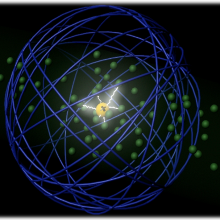Imagine a single giant atom, large enough that almost an entire sample of thousands of further atoms can fit inside. Such a situation has now been achieved and studied at the University of Stuttgart with an ultracold quantum gas, a Bose-Einstein condensate, from which the outermost electron of a single atom has been brought to a giant so-called Rydberg orbit. By confining the quantum gas in a tiny optical tweezer trap, the team realized electron orbits that were about three times larger than the typical extent of the atomic sample.
Apart from the fact that the preparation of such fragile orbits is a challenge by its own, the experiments allow now to observe the interaction of the positively charged ionic core of the Rydberg atom with the quantum gas, while the electron orbits most of its time outside the sample. In a way, the electron serves as a Faraday shield that protects the charged ion inside from being disturbed by detrimental electric stray fields. This approach could provide a new and exciting way to study the interaction of atoms and ions in an extremely low-temperature regime, where quantum effects are expected to start playing a role and may even lead to exotic and so far unexplored forms of matter.
K. S. Kleinbach, F. Engel, T. Dieterle, R. Löw, T. Pfau, and F. Meinert "Ionic Impurity in a Bose-Einstein Condensate at Submicrokelvin Temperatures", Phys. Rev. Lett. 120, 193401 (2018)
or on the arxiv: https://arxiv.org/abs/1802.08587


